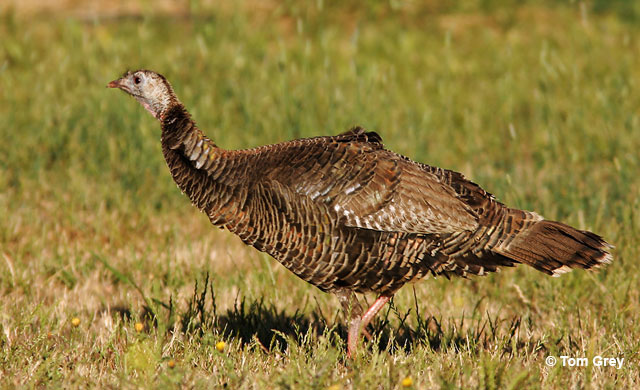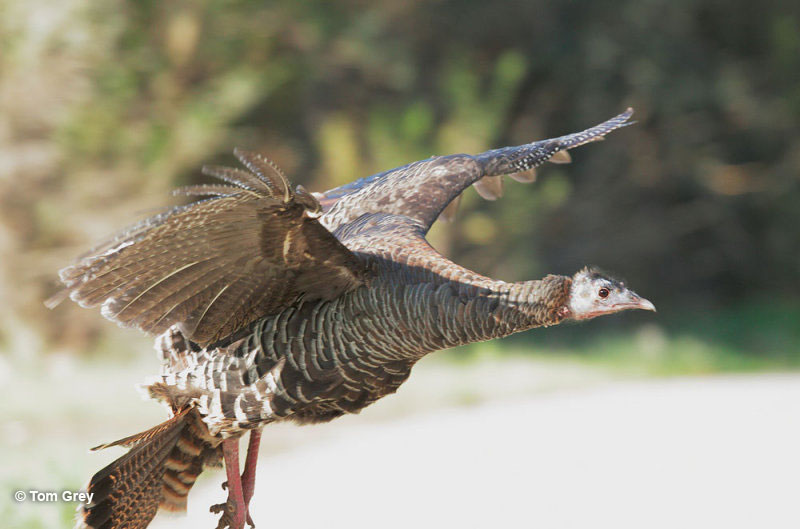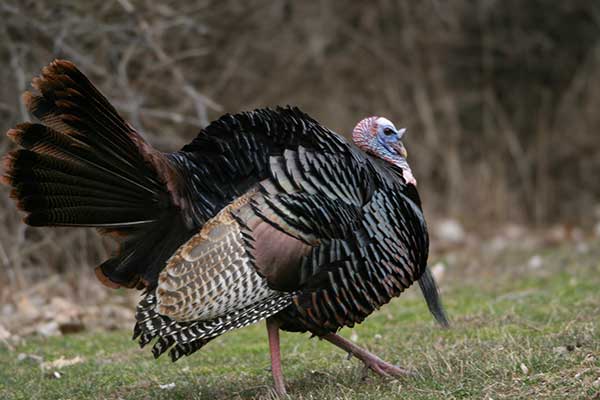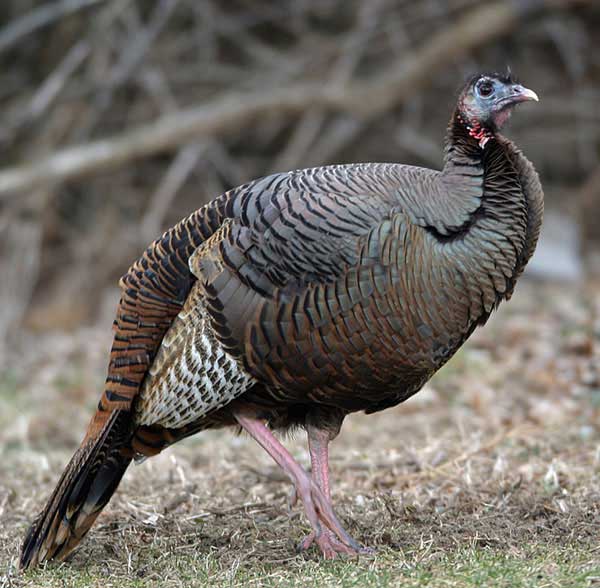
Determining the sex of a turkey can be a bit challenging, but with some basic information, it becomes quite easy.
Female turkeys, or “hens”, are smaller and less colorful, with shorter tails and legs.
Male turkeys, also known as “toms,” are generally larger in size and sport a prominent fleshy protuberance on their bills called a “snood.”
Female turkeys are called “hens“, male turkeys are called “toms“
In this guide, we’ll go over some of the key differences between male and female turkeys and give you tips on how to tell them apart.
On this page
Female vs Male Turkey
At first glance, it may seem that male and female turkeys are quite similar. However, upon closer examination, you will see that there are many differences between the two. From behavior to appearance, these birds have distinct characteristics that set them apart from one another.
Male turkeys, also known as “toms,” are known for their dominant behavior and aggressive mating displays. They will puff up their feathers, fan out their tail, and gobble to attract mates.
On the other hand, female turkeys, or “hens,” have more passive and nurturing behavior, spending much of their time searching looking after their young, but are aggressive when fending off predators to protect their offspring. This is one of the reasons females tend to have a lower life expectancy.

Female turkeys are smaller and have feathers on their heads and necks. © Tom Grey
Male turkeys are known for their distinctive gobbling sounds, which they use to attract mates and establish dominance. Female turkeys, on the other hand, make soft clucking sounds, which are used to communicate with their offspring and other hens.
Appearance-wise, males are generally larger and have longer tail feathers, as well as a fleshy protuberance hanging from their bill called a snood. Females are smaller and less colorful, with shorter tails and legs.
Male turkeys have feathery “beards” on their chests and although females typically do not have it, it is not a sure-fire way to distinguish them.
Scientific Information
| FEMALE TURKEY | MALE TURKEY | |
| AVG. LIFE EXPECTANCY | 3 years | 4 years |
| SIZE | Smaller.
Length: 36 inches Weight: 8-12 pounds |
Larger.
Length: 48 inches Weight: 15-25 pounds |
| APPEARANCE | Shorter legs and tails.
Duller and neutral coloring. Has some feathers on their head. Snood is very short. |
Longer legs and tails.
More colorful. Completely bald. Snood is long and hanging down from the bill. Spurs on legs. |
| PLUMAGE | Brown-tipped breast feathers.
Typically don’t have breast beards. Little shine to feathers. |
Black-tipped breast feathers.
Feathery beards on their chest. Iridescent feathers. |
| BEHAVIOR | Rarely fluff up their feathers.
Incubates and takes care of the young. |
Fan out their tail and fluff their plumage in display.
Provide no parental care. |
| SOUNDS | Do not gobble.
Yelp and cluck |
Gobble. |
| MISC. | Droppings are in a spiral shape. | Droppings are in a J-shape. |
Female Turkeys Are Smaller
Determining whether a turkey is male or female is easiest by looking at its size. Male turkeys, both wild and domesticated, are larger and heavier than females. Females are around 35 inches long and weigh 8-12 pounds, whereas the males are around 45-48 inches long and weigh 15-25 pounds.

Male turkeys are recognizable by their sheer size, especially when they look this magnificent.
Their weight fluctuates depending on food availability. Interestingly, their wingspan is quite similar, around 50-56 inches.
Female turkeys also have smaller and shorter legs than their male counterparts. A female turkey’s leg is on average 4.5 inches long, whereas a male turkey’s leg is 6 inches long. Males also have sharp spurs on their legs, which are at least half an inch long.
Female Turkeys Have Plumage on Their Heads
Another way to tell female and male turkeys apart is by looking at their heads. Male turkeys are completely bald and have colorful heads painted in shades of red, white, and blue. Females are more modest and have duller and more neutral-colored heads.
If you see a turkey with a few feathers on its head, then it’s definitely a female, since males are always bald.

Female turkey
Turkeys also have snoods, caruncles, and wattles. Both males and females have fleshy wart-like growths on their heads called caruncles. However, the snoods and wattles are different depending on the sex.
Males have long and drooping snoods whereas a female’s snood is short and small. Males also have larger red wattles that are basically fleshy lobes hanging from their chin or throat.
Female Turkeys Don’t Gobble
The distinctive “gobble” call is made primarily by male turkeys for the purpose of attracting females and deterring rivals and is unique to the male of the species, much like a rooster’s crow.
Gobbling is often performed from the treetop roosts, where the sound carries better, and it can elicit responses from other males.
Additionally, both male and female turkeys make a variety of other sounds such as cackling while flying down from roosts, soft purring calls while on foot, and a series of yelps to regroup the flock. Young turkeys also make a series of whistles when they are lost.
The male turkey also periodically makes a “chump” sound followed by a low hum, the source of which is not yet fully understood.
Female turkeys mostly cluck to communicate with each other and their young.
How to Tell Young Turkey’s Gender
Identifying the gender of baby turkeys, also known as poults, can be challenging as they look similar in their early stages. However, as they mature, they develop distinct characteristics that make gender identification easier.
To determine the gender of a baby turkey, examine its vent, which is located beneath its tail and between its legs. If the vent appears bumpy, the poult is male; if it is flat, the poult is female.
You can also determine its gender by picking it up and observing whether the chick pulls its legs up or leaves them dangling. Male poults tend to tuck in their legs when picked up, while female poults keep their legs dangling.
In addition, male poults tend to be more territorial and aggressive toward other birds and their companions than female poults.
Lifecycle of Female Turkeys
Wild turkeys breed once per year and have 4-17 eggs in a clutch. After mating, the female turkey is on her own and has to incubate and take care of the younglings with no help from the male.
The incubation takes around 25-31 days, and the chicks stay in the nest for only the first day. The female broods them at night for several weeks.
The females and chicks travel in groups with each other, forming large flocks of young turkeys with multiple adult females. The younglings follow the females and forage their own food. They reach independence in 4-10 months.
Frequently Asked Questions
What are female turkey’s called?
Female turkeys are called hens.
How can you tell a female turkey?
You can tell it’s a female turkey by the fact that it is smaller and more modest than its male counterpart. Females are duller, have shorter tails and legs, and have some feathers on their heads.
Do turkeys mate for life?
Turkeys do not mate for life, they don’t even choose one partner for one season and mate with multiple individuals. Males provide no parental care for the younglings.
Conclusions
In conclusion, although male and female turkeys look similar at first glance, they have many differences in their behavior, appearance, sounds, and other characteristics.
Males are larger and have longer tails and legs, a long and droopy snood on their bill, and make a distinctive gobbling sound. Females are smaller, have shorter tails and legs, have duller coloring, make soft clucking sounds, and aren’t as aggressive with members of their own species.
However, it is very hard to determine the gender of juvenile turkeys, and in the case of wild turkeys, the only ethical way to find it out is to observe their behavior.

Sam
Sunday 20th of August 2023
How about clearly labeling each picture on this page male or female?
Patrick O'Donnell
Monday 21st of August 2023
@Sam- Good idea, thanks!